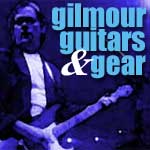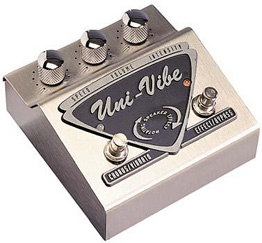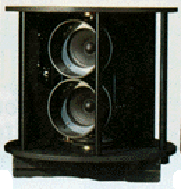


Gilmour, Guitars & Gear
Rotating Speaker Sound
 In this column, I'll be examining Pink Floyd guitarist David Gilmour's gear and playing techniques from a musician's point of view. Please feel free to e-mail me with questions and ideas for future articles if you feel you have an idea that readers of Spare Bricks might find of interest. Past articles are now posted at web.tampabay.rr.com/richm/sbarchive.htm.
In this column, I'll be examining Pink Floyd guitarist David Gilmour's gear and playing techniques from a musician's point of view. Please feel free to e-mail me with questions and ideas for future articles if you feel you have an idea that readers of Spare Bricks might find of interest. Past articles are now posted at web.tampabay.rr.com/richm/sbarchive.htm.
While recording "Little Wing" in 1968, Jimi Hendrix reportedly plugged his guitar amplifier into a Leslie speaker cabinet. Leslie rotating speaker cabinets were the norm for a Hammond organ, but Hendrix's use of his guitar amp into the cabinet created a sound that many guitarists would seek to emulate. One such guitarist is David Gilmour, who has used the rotating speaker effect as a foundation of his guitar sound since his early days in Pink Floyd.
 The Uni-Vibe pedal. |
Initially, Gilmour used Leslie cabinets on tour. The cabinets contained a pair of rotating speakers that included a 15-inch speaker pointed towards the ground. As the speakers rotate within the cabinet, a phase effect is created. The level of the effect depends on the rotation speed of the speakers.
Gilmour used rotating Leslie guitar cabinets extensively on Pink Floyd's 1973 release, Dark Side Of The Moon. The Leslie cabinets were used in sessions for "Breathe," "On the Run," "Any Colour You Like," "Brain Damage" and "Eclipse."
A company called Univox created a guitar effect to reproduce the rotating speaker sound. This effect is known as the Uni-Vibe. The pedal included controls for volume and intensity as well as a switch for chorus or vibrato. This model also came with a footswitch to control the speed of the rotating effect. The effect is currently made by Dunlop.
"Any Colour You Like," from Dark Side of the Moon featured Gilmour's Uni-Vibe and was influenced by Eric Clapton's use of the effect.
Gilmour's Uni-Vibe was used in concerts dating back to 1972 for early live performances of Dark Side of the Moon. The effect was used on many of the tours that followed, 1973-1974 for Dark Side of the Moon, 1975 for Wish You Were Here, 1980-81 for The Wall and 1994 for The Division Bell.
 The Uni-Vibe rack effect. |
Gilmour also used a pair of 200-watt Yamaha RA-200 Leslie Amplifiers during recording sessions for "Dogs" from 1977's Animals. In addition, Gilmour used the same Yamaha speaker cabinets for his solos during "Comfortably Numb" from The Wall. The same set of Yamaha cabinets were also used during The Wall tour in 1980-81.
By the 1994 tour, Gilmour's Uni-Vibe had been changed to a rack effect. Gilmour's long-time guitar technician Phil Taylor even had the original logo and controls imprinted on the unit's faceplate.
 The "Doppola" rotating speaker. |
On Pink Floyd's 1995 live release, Pulse, the second song on disc two, "Breathe" stands out as one of the best examples of the Uni-Vibe effect. The Uni-Vibe was also used on the guitar solo for "Time," and was also reportedly used on "Any Colour You Like," "Brain Damage," and "Eclipse" during the Dark Side of the Moon set of the tour.
In sessions for 1994's The Division Bell, Gilmour started using a Maestro Rover revolving speaker that he would place on top of his studio amplifiers. This inspired the creation of rotating speakers for the subsequent tour. Three sets of rotating speaker cabinets, referred to as "Doppolas", were used in 1994. The speakers included a pair of 6-inch, 100-watt drivers. The three speakers were used in tandem with Gilmour's 4 x 12-inch speaker cabinets through the duration of the concerts.